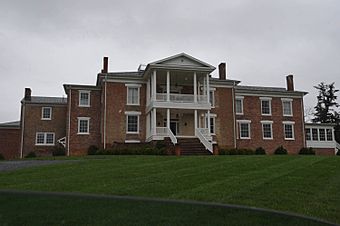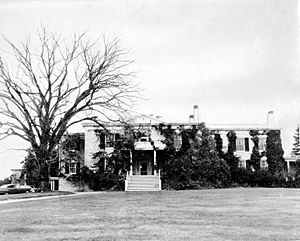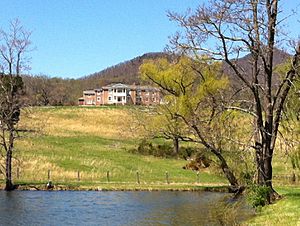Greyledge facts for kids
|
Greyledge
|
|
 |
|
| Location | 1066 Greyledge Rd., near Buchanan, Virginia |
|---|---|
| Area | 800 acres (320 ha) |
| Built | c. 1842, 1906 |
| Built by | Cartmill brothers |
| Architectural style | Greek Revival |
| NRHP reference No. | 01001571 |
Quick facts for kids Significant dates |
|
| Added to NRHP | February 5, 2002 |
Greyledge is a special old house and a historic area in Botetourt County, Virginia. It includes the main house and many other old buildings, plus lots of woods and farmland. Even though it's close to a big highway (Interstate 81), you can't see the house from the road. The house sits on a hill about 1,200 feet high. From Greyledge, you can see Purgatory Mountain and the beautiful Blue Ridge Mountains. A stream called Purgatory Creek flows through the property and into the James River nearby.
Contents
A Look Back: Greyledge's History
The main house at Greyledge was started around 1842. It was built by the Cartmill brothers for their cousin, Ann Sisson. She had lost her parents and inherited the land. The house was finished around 1855.
Early Owners and Changes
Ann Sisson later married Charles Gorgas. When he passed away in 1862, Ann inherited even more land. She then married Henry Hansborough in 1866. After Ann died in 1885, the property was sold.
In 1895, a lawyer and mining expert named Edmund Cash Pechin bought Greyledge. He was involved with railroads and a company in Roanoke. Mr. Pechin and his wife, Mary, made Greyledge their grand home. Mary was also active in the local community, helping to improve the town of Buchanan.
New Families and Renovations
After the Pechins passed away in the 1920s, their daughter Bertha inherited Greyledge. Later, Stuart B. Carter, a lawyer and state leader from Virginia, bought the house. He was Bertha Pechin's nephew by marriage. Stuart Carter was important because he helped stop a policy called "Massive Resistance" in Virginia. This policy tried to prevent schools from integrating (allowing students of all races to attend together).
The Carter family made many updates and repairs to Greyledge. Their children later inherited the property. More renovations and improvements began after the house was sold again in 2001.
The Design of Greyledge
The main house at Greyledge is built in the Greek Revival style. This means it looks like ancient Greek temples, with a focus on balance and classic shapes.
Building Materials and Style
The house has two stories and is made of brick. The bricks for the original house were made right there on the property by enslaved people. The front of the house has a special brick pattern called "Flemish bond." The sides and back use a different pattern called "stretcher bond."
In 1906, the Pechin family added a new two-story section to the east side of the house and a front porch. These new parts were built with a different brick pattern and were painted. Later, more sections were added to connect the kitchen and an ice house to the main building. These parts were made of wood.
Other Buildings on the Property
Around the main house, there are several other historic buildings. These include:
- A potato cellar and a building for acetylene gas (used for lighting)
- A cistern (a tank for collecting rainwater) from around 1900
- A washhouse, which later became an apartment
- A garage and a barn, also built around 1900
Later, around 1930, a machinery shed and a chicken house were added. The property also has a pet cemetery from the 20th century and a lake built in 1946.
Other Areas of the Estate
There's another group of buildings near what was called the "Gate House." This area includes another barn, a well with a gazebo (a small, open building), and a garage built in the 1930s. A modern shed is also there.
A third area has the "Creek House" and a well from the early 1900s. Some newer buildings like a shed, pig pen, and outhouse are also in this area, but they are not considered part of the historic district. A water tower that used to be there was removed around 1960.
Greyledge was recognized as a Virginia Landmark in September 2001. It was then added to the National Register of Historic Places in 2002, which means it's a very important historic site in the United States.
Images for kids





